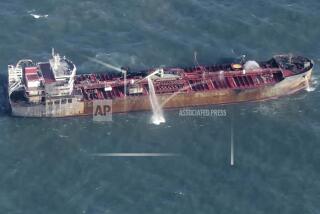Oil Slick Is Traced to Sunken Ship
- Share via
A mysterious, recurrent oil slick that has killed thousands of seabirds has been traced to a freighter that sank off the Northern California coast almost 50 years ago, the Coast Guard said Friday.
The culprit is the Jacob Luckenbach, a 468-foot ship that collided with another vessel in 1953 and sank about 17 miles southwest of the Golden Gate Bridge.
The oil that has been leaking off and on ever since apparently has come from the Luckenbach’s fuel tanks and not from its cargo of automobiles and heavy machinery, said Lt. Tim Callister, a spokesman for the Coast Guard in the Bay Area city of Alameda.
Identifying the source of the slick, which has killed almost 1,000 birds since its latest appearance in November, was the result of a painstaking and expensive bit of high-tech detective work by a task force of federal and state agencies.
Experts analyzed the oil that has been oozing up, soon concluding that it wasn’t from a natural oil seep, and probably was crude oil or the sort of heavy fuel oil used to power many ships.
Lab tests revealed a specific “fingerprint” for the oil, and the task force was able to rule out spills from tankers passing near the Farallon Islands, the area from which the oil seemed to be emanating.
Samples from equally mysterious oil slicks in the winters of 1992-93, 1997-98, 1999 and 2001 had the same fingerprint. The leak in 1997-98 killed more than 2,000 birds.
Searching through maritime records, investigators soon homed in on about a dozen ships known to have sunk near the Farallons. They included the tanker Puerto Rican, which exploded and sank in 1984; the aircraft carrier Independence, which was intentionally sunk in the 1950s; two Navy tankers that went down during storms in the 1950s; and a couple of freighters, including the Luckenbach.
The records showed that a sister ship, the Hawaiian Pilot, slammed into the Luckenbach in heavy fog on July 14, 1953. The Luckenbach, mortally wounded, went down in less than 30 minutes. All 36 on board were transferred to the other ship, which was able to continue to San Francisco.
On Tuesday, using a remote-controlled submarine that costs $24,000 a day to operate, the task force studied the ocean-floor wreckage of the Luckenbach with a television camera.
“The camera did not show any direct evidence of oil coming from the ship, but [it] did observe minor amounts of oil moving about in one of the vessel’s cargo holds,” the Coast Guard said. In addition, small amounts were found on the surface above the ship.
Samples of oil from the surface were taken to a state Fish and Game lab near Sacramento and a Coast Guard lab in Connecticut. The samples were compared with the oil fingerprinted earlier. The oils matched.
“This is very exciting,” said Bill Castle, supervising chemist at the state Fish and Game laboratory. “There’s a real sense of relief, because these spills create a big problem for us and our wildlife.”
The Navy has been asked to offer suggestions on how the ship might be recovered.
More to Read
Sign up for Essential California
The most important California stories and recommendations in your inbox every morning.
You may occasionally receive promotional content from the Los Angeles Times.












